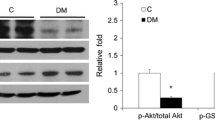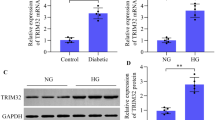Abstract
Diabetic nephropathy, which is associated with loss of human (h) podocytes (PC), is a major complication in diabetes mellitus. High-glucose modulates AMP-activated protein kinase (AMPK) signaling and cell apoptosis. Metformin has been demonstrated to reduce apoptosis and albuminuria in type 2 diabetes. Here, we examined the effect of metformin on cell apoptosis and on pro-/anti-apoptotic signaling in hPC. Expression analyses were done by real-time polymerase chain reaction and western blotting. Moreover, a functional apoptosis assay was performed in hPC. Determination of kinase activation by phosphorylation was done via immunodetection analyses and digital quantification. We found that hPC express organic cation transporter 1 which is the major uptake transporter of metformin. High-glucose reduced AMPK phosphorylation and induced mammalian target of rapamycin (mTOR) activation in podocytes, which was abolished and reversed by pre-treatment with metformin. Furthermore, metformin reduced high-glucose-induced podocytes apoptosis in a concentration-dependent manner. In summary, metformin exhibits an anti-apoptotic impact on podocytes under high-glucose conditions via activation of AMPK and inhibition of mTOR signaling. These data support a beneficial effect of metformin in diabetic nephropathy.





Similar content being viewed by others
References
Papale M, Di PS, Vocino G, Rocchetti MT, Gesualdo L (2014) Proteomics and diabetic nephropathy: what have we learned from a decade of clinical proteomics studies? J Nephrol 27:221–228
Wolf G, Ziyadeh FN (2007) Cellular and molecular mechanisms of proteinuria in diabetic nephropathy. Nephron Physiol 106:26–31
Ijpelaar DH, Schulz A, Koop K, Schlesener M, Bruijn JA, Kerjaschki D, Kreutz R, de Heer E (2008) Glomerular hypertrophy precedes albuminuria and segmental loss of podoplanin in podocytes in Munich-Wistar-Fromter rats. Am J Physiol Renal Physiol 294:F758–F767
Ni L, Saleem M, Mathieson PW (2012) Podocyte culture: tricks of the trade. Nephrology (Carlton) 17:525–531
Manabe I (2011) Chronic inflammation links cardiovascular, metabolic and renal diseases. Circ J 75:2739–2748
Ishikawa Y, Gohda T, Tanimoto M, Omote K, Furukawa M, Yamaguchi S, Murakoshi M, Hagiwara S, Horikoshi S, Funabiki K, Tomino Y (2012) Effect of exercise on kidney function, oxidative stress, and inflammation in type 2 diabetic KK-A(y) mice. Exp Diabetes Res 2012:702948
Kim J, Shon E, Kim CS, Kim JS (2012) Renal podocyte injury in a rat model of type 2 diabetes is prevented by metformin. Exp Diabetes Res 2012:210821
Wei M, Li Z, Yang Z (2014) Crosstalk between protective autophagy and NF-kappaB signal in high glucose-induced podocytes. Mol Cell Biochem 394:261–273
Eid AA, Ford BM, Block K, Kasinath BS, Gorin Y, Ghosh-Choudhury G, Barnes JL, Abboud HE (2010) AMP-activated protein kinase (AMPK) negatively regulates Nox4-dependent activation of p53 and epithelial cell apoptosis in diabetes. J Biol Chem 285:37503–37512
Rocha A, Almeida M, Santos J, Carvalho A (2013) Metformin in patients with chronic kidney disease: strengths and weaknesses. J Nephrol 26:55–60
Amador-Licona N, Guizar-Mendoza J, Vargas E, Sanchez-Camargo G, Zamora-Mata L (2000) The short-term effect of a switch from glibenclamide to metformin on blood pressure and microalbuminuria in patients with type 2 diabetes mellitus. Arch Med Res 31:571–575
Yeh CH, Chen TP, Wang YC, Lin YM, Fang SW (2010) AMP-activated protein kinase activation during cardioplegia-induced hypoxia/reoxygenation injury attenuates cardiomyocytic apoptosis via reduction of endoplasmic reticulum stress. Mediators Inflamm 2010:130636
Xu X, Lu Z, Fassett J, Zhang P, Hu X, Liu X, Kwak D, Li J, Zhu G, Tao Y, Hou M, Wang H, Guo H, Viollet B, McFalls EO, Bache RJ, Chen Y (2014) Metformin protects against systolic overload-induced heart failure independent of AMP-activated protein kinase alpha2. Hypertension 63:723–728
Rogacka D, Piwkowska A, Audzeyenka I, Angielski S, Jankowski M (2014) Involvement of the AMPK-PTEN pathway in insulin resistance induced by high glucose in cultured rat podocytes. Int J Biochem Cell Biol 51:120–130
Ha TS, Choi JY, Park HY, Han GD (2013) Changes of podocyte p130Cas in diabetic conditions. J Nephrol 26:870–876
Eisenreich A, Boltzen U, Malz R, Schultheiss HP, Rauch U (2011) Overexpression of alternatively spliced tissue factor induces the pro-angiogenic properties of murine cardiomyocytic HL-1 cells. Circ J 75:1235–1242
Eisenreich A, Boltzen U, Poller W, Schultheiss HP, Rauch U (2008) Effects of the Cdc2-like kinase-family and DNA topoisomerase I on the alternative splicing of eNOS in TNF-alpha-stimulated human endothelial cells. Biol Chem 389:1333–1338
Chen L, Shu Y, Liang X, Chen EC, Yee SW, Zur AA, Li S, Xu L, Keshari KR, Lin MJ, Chien HC, Zhang Y, Morrissey KM, Liu J, Ostrem J, Younger NS, Kurhanewicz J, Shokat KM, Ashrafi K, Giacomini KM (2014) OCT1 is a high-capacity thiamine transporter that regulates hepatic steatosis and is a target of metformin. Proc Natl Acad Sci USA 111:9983–9988
Eisenreich A, Rauch U (2011) PI3K inhibitors in cardiovascular disease. Cardiovasc Ther 29:29–36
Chaudhary SC, Kurundkar D, Elmets CA, Kopelovich L, Athar M (2012) Metformin, an antidiabetic agent reduces growth of cutaneous squamous cell carcinoma by targeting mTOR signaling pathway. Photochem Photobiol 88:1149–1156
Lin CL, Lee PH, Hsu YC, Lei CC, Ko JY, Chuang PC, Huang YT, Wang SY, Wu SL, Chen YS, Chiang WC, Reiser J, Wang FS (2014) MicroRNA-29a promotion of nephrin acetylation ameliorates hyperglycemia-induced podocyte dysfunction. J Am Soc Nephrol 25:1698–1709
Komazawa H, Yamaguchi H, Hidaka K, Ogura J, Kobayashi M, Iseki K (2013) Renal uptake of substrates for organic anion transporters Oat1 and Oat3 and organic cation transporters Oct1 and Oct2 is altered in rats with adenine-induced chronic renal failure. J Pharm Sci 102:1086–1094
Tzvetkov MV, Vormfelde SV, Balen D, Meineke I, Schmidt T, Sehrt D, Sabolic I, Koepsell H, Brockmoller J (2009) The effects of genetic polymorphisms in the organic cation transporters OCT1, OCT2, and OCT3 on the renal clearance of metformin. Clin Pharmacol Ther 86:299–306
Eid AA, Ford BM, Bhandary B, de Cassia CR, Block K, Barnes JL, Gorin Y, Choudhury GG, Abboud HE (2013) Mammalian target of rapamycin regulates Nox4-mediated podocyte depletion in diabetic renal injury. Diabetes 62:2935–2947
Piwkowska A, Rogacka D, Jankowski M, Dominiczak MH, Stepinski JK, Angielski S (2010) Metformin induces suppression of NAD(P)H oxidase activity in podocytes. Biochem Biophys Res Commun 393:268–273
Katta A, Kakarla S, Wu M, Paturi S, Gadde MK, Arvapalli R, Kolli M, Rice KM, Blough ER (2009) Altered regulation of contraction-induced Akt/mTOR/p70S6k pathway signaling in skeletal muscle of the obese Zucker rat. Exp Diabetes Res 2009:384683
Mariappan MM (2012) Signaling mechanisms in the regulation of renal matrix metabolism in diabetes. Exp Diabetes Res 2012:749812
Takiyama Y, Harumi T, Watanabe J, Fujita Y, Honjo J, Shimizu N, Makino Y, Haneda M (2011) Tubular injury in a rat model of type 2 diabetes is prevented by metformin: a possible role of HIF-1alpha expression and oxygen metabolism. Diabetes 60:981–992
Shiu SW, Wong Y, Tan KC (2012) Effect of advanced glycation end products on lectin-like oxidized low density lipoprotein receptor-1 expression in endothelial cells. J Atheroscler Thromb 19:1083–1092
Tadakawa M, Takeda T, Li B, Tsuiji K, Yaegashi N (2014) The anti-diabetic drug metformin inhibits vascular endothelial growth factor expression via the mammalian target of rapamycin complex 1/hypoxia-inducible factor-1alpha signaling pathway in ELT-3 cells. Mol Cell Endocrinol 399:1–8
Simon-Szabo L, Kokas M, Mandl J, Keri G, Csala M (2014) Metformin attenuates palmitate-induced endoplasmic reticulum stress, serine phosphorylation of IRS-1 and apoptosis in rat insulinoma cells. PLoS One 9:e97868
Song H, Han IY, Kim Y, Kim YH, Choi IW, Seo SK, Jung SY, Park S, Kang MS (2015) The NADPH oxidase inhibitor DPI can abolish hypoxia-induced apoptosis of human kidney proximal tubular epithelial cells through Bcl2 up-regulation via ERK activation without ROS reduction. Life Sci 126:69–75
Mitu GM, Wang S, Hirschberg R (2007) BMP7 is a podocyte survival factor and rescues podocytes from diabetic injury. Am J Physiol Renal Physiol 293:F1641–F1648
Hashemitabar M, Bahramzadeh S, Saremy S, Nejaddehbashi F (2015) Glucose plus metformin compared with glucose alone on beta-cell function in mouse pancreatic islets. Biomed Rep 3:721–725
Wu D, Wen W, Qi CL, Zhao RX, Lu JH, Zhong CY, Chen YY (2012) Ameliorative effect of berberine on renal damage in rats with diabetes induced by high-fat diet and streptozotocin. Phytomedicine 19:712–718
Tang SC, Leung JC, Chan LY, Cheng AS, Lan HY, Lai KN (2010) Renoprotection by rosiglitazone in accelerated type 2 diabetic nephropathy: role of STAT1 inhibition and nephrin restoration. Am J Nephrol 32:145–155
Tzeng TF, Liou SS, Chang CJ, Liu IM (2013) The ethanol extract of zingiber zerumbet attenuates streptozotocin-induced diabetic nephropathy in rats. Evid Based Complement Altern Med 2013:340645
Author information
Authors and Affiliations
Corresponding author
Ethics declarations
Conflict of interest
None of the authors has any potential conflicts of interest associated with this research. This article does not contain any studies with human participants or animals performed by any of the authors.
Ethical approval
All procedures used in this study are in accordance with institutional and international ethical standards.
Informed consent
For this type of study no formal consent was required.
Rights and permissions
About this article
Cite this article
Langer, S., Kreutz, R. & Eisenreich, A. Metformin modulates apoptosis and cell signaling of human podocytes under high glucose conditions. J Nephrol 29, 765–773 (2016). https://doi.org/10.1007/s40620-015-0258-1
Received:
Accepted:
Published:
Issue Date:
DOI: https://doi.org/10.1007/s40620-015-0258-1




